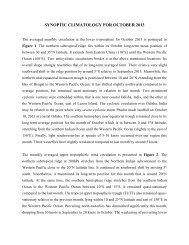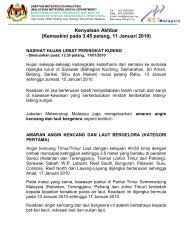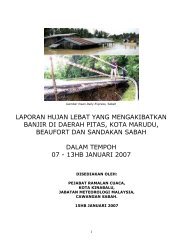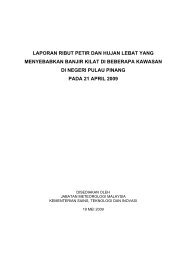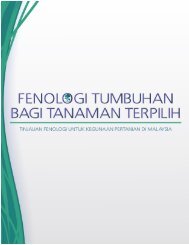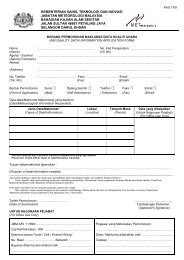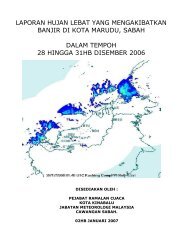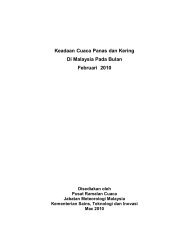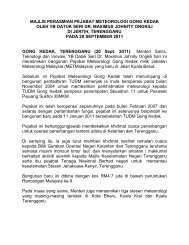Download
Download
Download
You also want an ePaper? Increase the reach of your titles
YUMPU automatically turns print PDFs into web optimized ePapers that Google loves.
National Hydraulic Research Institute of Malaysia, Ministry of Natural Resources and Environment (NRE)<br />
2 nd National Conference on Extreme Weather and Climate Change<br />
PICC, Putrajaya, , 14-15 15 Oct 2008<br />
CLIMATE CHANGE &<br />
WATER RESOURCES MANAGEMENT<br />
IN MALAYSIA<br />
Salmah Zakaria<br />
Director General, Hydraulic Research Institute of Malaysia , (NAHRIM)<br />
&<br />
Liew Yuk San<br />
Research Officer, NAHRIM
National Hydraulic Research Institute of Malaysia, Ministry of Natural Resources and Environment (NRE)<br />
Outlined<br />
1. IMPACT OF CLIMATE CHANGE ON WATER<br />
RESOURCES<br />
2. WATER RESOURCES STATUS &<br />
CHALLENGES<br />
3. INTEGRATED WATER RESOURCES<br />
MANAGEMENT (IWRM)<br />
4. THE WAY FORWARD<br />
5. SUMMARY
National Hydraulic Research Institute of Malaysia, Ministry of Natural Resources and Environment (NRE)<br />
Outlined<br />
1. IMPACT OF CLIMATE CHANGE ON WATER<br />
RESOURCES<br />
2. WATER RESOURCES STATUS &<br />
CHALLENGES<br />
3. INTEGRATED WATER RESOURCES<br />
MANAGEMENT (IWRM)<br />
4. THE WAY FORWARD<br />
5. SUMMARY
• CGCM1 spatial grid resolution on the order of 410<br />
km over Peninsular Malaysia<br />
• Regional and watershed scales<br />
• more refined topographic & land surface characteristics<br />
have profound impact on regional climate<br />
• land use patterns/changes impact regional climate<br />
conditions<br />
• Regional Hydroclimate Model of Peninsular<br />
Malaysia (RegHCM-PM)’ was developed in order to<br />
downscale the global climate change simulation data<br />
(Canadian CGCM1 current and future climate data) that<br />
are at very coarse resolution (~ 410km), to Peninsular<br />
Malaysia at fine spatial resolution (~9km).<br />
National Hydraulic Research Institute of Malaysia, Ministry of Natural Resources and Environment (NRE)
National Hydraulic Research Institute of Malaysia, Ministry of Natural Resources and Environment (NRE)<br />
Model Schematization Nesting 1 st Domains<br />
1. 1st domain is longitudes span<br />
from East 91 o -114<br />
o and its<br />
latitudes span from 5 o S to 15 o<br />
N.<br />
2. 1st domain has 23 x 24 grids<br />
and a grid resolution of 81 km,<br />
which covers a region of 1863<br />
km x 1944 km<br />
3. RegHCM-PM is nested into the<br />
First Generation Coupled<br />
General Circulation Model of<br />
the Canadian GCM (CGCM1)<br />
4. CGCM1 provides the initial<br />
fields and boundary conditions<br />
to the RegHCM-PM, and then<br />
the CGCM1 simulation results<br />
are downscaled to the region<br />
of Peninsular Malaysia through<br />
several nesting procedures.
National Hydraulic Research Institute of Malaysia, Ministry of Natural Resources and Environment (NRE)<br />
Model Schematization Nesting 1 st Domains<br />
1. The grid layout for the 1st<br />
domain of the RegHCM-<br />
PM under Mercator<br />
projection. GTOPO30 DEM<br />
of the region is overlaid<br />
on the outer domain grids.<br />
2. Regional Hydroclimate<br />
model (RegHCM) of<br />
Peninsular Malaysia was<br />
run first with its initial and<br />
boundary conditions<br />
provided from CGCM1<br />
global historical<br />
atmospheric simulation<br />
data at 1st domain,<br />
covering the whole<br />
Peninsular Malaysia region<br />
and the surrounding areas
National Hydraulic Research Institute of Malaysia, Ministry of Natural Resources and Environment (NRE)<br />
Model Schematization Nesting 2 nd and 3 rd Domains<br />
1. The 2 nd domain with 34 x 37<br />
grids and a grid resolution of<br />
27 km, which covers a region<br />
of 918 km x 999 km, is nested<br />
within the center of the 1st<br />
domain.<br />
2. The inner domain (the 3 rd<br />
domain) is nested within the<br />
center of the 2nd domain &<br />
has 64 x 76 grids at a grid<br />
resolution of 9 km, and covers<br />
a region of 576 km x 684 km.<br />
3. The 3 rd domain is the inner<br />
domain of the updated<br />
RegHCM-PM, which<br />
encompasses the entire<br />
Peninsular Malaysia and covers<br />
a part of Thailand in the north,<br />
Singapore in the south, and a<br />
part of Indonesia in the<br />
southeast.
The Findings of the 2006 Study<br />
National Hydraulic Research Institute of Malaysia, Ministry of Natural Resources and Environment (NRE)
Summary of Monthly Precipitation<br />
National Hydraulic Research Institute of Malaysia, Ministry of Natural Resources and Environment (NRE)<br />
Sub-region Name<br />
West<br />
Coast<br />
Klang<br />
Selangor<br />
Terenggau<br />
Kelantan<br />
Pahang Perak Kedah Johor<br />
Maximum<br />
Monthly<br />
Precip<br />
(mm)<br />
Mean<br />
Monthly<br />
Precip<br />
(mm)<br />
Minimum<br />
Monthly<br />
Precip<br />
(mm)<br />
Historical 600.0 436.2 564.1 1271.2 929.7 633.6 722.9 626.7 591.7<br />
Future 560.3 601.3 525.7 1913.9 1128.5 684.6 767.8 705.3 538.2<br />
Diff. -39.7 165.1 -38.4 +642.7 +198.8 +51.0 +44.9 +78.3 -53.5<br />
(%) -6.6 +37.8 -6.8 +50.6 +21.4 +8.0 +6.21 +12.5 -9.0<br />
Historical 179.2 190.1 190.2 289.0 221.8 198.5 192.9 173.6 187.3<br />
Future 176.2 182.3 180.9 299.0 239.5 208.4 199.4 176.6 180.0<br />
Diff. -3.0 -7.8 -9.3 +10.0 +17.7 +9.9 +6.5 +3.0 -7.3<br />
(%) -1.7 -4.1 +4.9 +3.5 +7.9 +4.9 +3.4 +1.7 -3.9<br />
Historical 12.4 12.8 12.2 33.6 15.4 24.5 9.0 2.1 13.3<br />
Future 7.9 5.9 8.3 14.0 10.9 16.6 4.1 1.1 5.2<br />
Diff. -4.5 -6.9 -3.9 -19.6 -4.5 -7.9 -4.9 -1.0 -8.1<br />
(%) -36.3 -53.9 -32 -58.3 -29.2 -32.2 -54.4 -50 -60.9
National Hydraulic Research Institute of Malaysia, Ministry of Natural Resources and Environment (NRE)<br />
Future Rainfall<br />
• In annual rainfall:<br />
10% increase for Kelantan, Terengganu and Pahang<br />
5% decrease for Selangor and Johor<br />
• More droughts ie dry years (from modelling output: 2028,<br />
2029, 2034, 2042 and 2044)<br />
• A increase up to 51% in maximum monthly rainfall over<br />
the North East Coastal region<br />
• A decrease in minimum monthly rainfall over Selangor (-<br />
32%) and Johor (-61% )<br />
• More extreme hydrological conditions may be expected
National Hydraulic Research Institute of Malaysia, Ministry of Natural Resources and Environment (NRE)<br />
Summary of Monthly Flows<br />
River Klang Selangor Dungun<br />
Kelantan<br />
Pahang Perak Muda Johor<br />
Maximum<br />
Monthly<br />
Flows<br />
(cms)<br />
Mean<br />
Monthly<br />
Flows<br />
(cms)<br />
Minimum<br />
Monthly<br />
Flows<br />
(cms)<br />
Historical 31.2 107.9 398.4 1535.1 1697.4 523.7 307.4 82.7<br />
Future 45.8 108.5 569.5 1950.7 2176.6 578.2 340.0 94.0<br />
Diff. +14.6 +0.6 +171.1 +415.6 +479.2 +54.5 +32.6 +11.3<br />
(%) +46.8 +0.6 +42.9 +27.1 +28.2 +10.4 +10.6 +13.7<br />
Historical 14.4 40.7 93.4 535.9 669.6 286.4 105.6 32.7<br />
Future 13.3 37.5 98.3 601.7 718.1 299.7 104.0 31.8<br />
Diff. -1.1 -3.2 +4.9 +65.8 +48.5 +13.3 -1.6 -0.9<br />
(%) -7.6 -7.9 +5.2 +12.3 +7.2 +4.6 -1.5 -2.8<br />
Historical 2.6 7.1 13.1 158.4 156.3 183.6 25.3 9.8<br />
Future 3.5 0.5 10.8 125.8 122.7 139.2 5.3 6.8<br />
Diff. +0.9 -6.6 -2.3 -32.6 -33.6 -44.4 -20 -3<br />
(%) +34.6 -93.0 -17.6 -20.6 -21.5 -24.2 -79.1 -30.6
National Hydraulic Research Institute of Malaysia, Ministry of Natural Resources and Environment (NRE)<br />
Future River Flow<br />
• Future monthly flows - the maximum monthly flows will<br />
be significantly higher (+11% to +43%) for Kelantan,<br />
Terengganu and Pahang and the minimum monthly<br />
flows significantly lower (-31% to -93%) for Selangor<br />
and Johor<br />
• An increase in inter-annual and intra-seasonal variability<br />
with increased hydrologic extremes (higher high flows,<br />
and lower low flows) in Kelantan, Pahang, Terengganu<br />
and Kedah watersheds<br />
• Expect more severe floods and droughts
National Hydraulic Research Institute of Malaysia, Ministry of Natural Resources and Environment (NRE)<br />
Summary of Monthly Air Temperature<br />
Subregion Name West Coast Klang Selangor<br />
Terengganu<br />
Kelantan<br />
Pahang<br />
Maximum<br />
Monthly<br />
Air Temp<br />
(deg C)<br />
Mean<br />
Monthly<br />
Air<br />
Temp<br />
(deg C)<br />
Minimum<br />
Monthly<br />
Air<br />
Temp<br />
(deg C)<br />
Historical 28.9 27.7 27.7 28.2 28.0 28.3<br />
Future 30.7 29.7 29.5 29.9 29.6 29.9<br />
Increase 1.8 2.0 1.8 1.7 1.6 1.6<br />
% Increase 6.2% 7.2% 6.5% 6.0% 5.7% 5.7%<br />
Historical 27.3 26.5 26.4 25.5 25.3 26.1<br />
Future 28.6 27.9 27.8 26.8 26.5 27.4<br />
Increase 1.3 1.4 1.4 1.3 1.2 1.3<br />
% Increase 4.7% 5.3% 5.3% 5.1% 4.7% 5.0%<br />
Historical 24.9 24.8 24.7 21.9 21.0 22.8<br />
Future 26.2 25.5 25.4 23.1 22.4 24.1<br />
Increase 1.3 0.7 0.7 1.2 1.4 1.3<br />
% Increase 5.2% 2.8% 2.8% 5.5% 6.7% 5.7%
National Hydraulic Research Institute of Malaysia, Ministry of Natural Resources and Environment (NRE)<br />
Future Air Temperature<br />
• There is an indicative uniform increase of annual<br />
air temperature by about 1 to 1.5ºC over all<br />
regions of Peninsular Malaysia.
National Hydraulic Research Institute of Malaysia, Ministry of Natural Resources and Environment (NRE)<br />
Climate Change Projection<br />
GLOBAL*<br />
MALAYSIA**<br />
2050 2100 2050<br />
Surface temperature (ºC)<br />
(Emission Scenario SRES<br />
A1B)<br />
1.6 2.8 1.5<br />
Sea level rise (m)<br />
(Emission Scenario SRES<br />
A1B)<br />
0.21-<br />
0.48<br />
-<br />
Monthly Rainfall (mm)<br />
Monthly River Flows (m3/s)<br />
+51% Northeast Coast of Peninsula<br />
- 61% (Johor)<br />
+11% to +43% (Flood Flows)<br />
-31% to -93% (Low Flows)
National Hydraulic Research Institute of Malaysia, Ministry of Natural Resources and Environment (NRE)<br />
Observed Climate Change<br />
GLOBAL*<br />
MALAYSIA**<br />
1906-2005 1968-2002<br />
Surface<br />
temperature (ºC)<br />
0.74 0.41-0.91<br />
(MMD)<br />
1961-2003 1993-2003 1986-2006<br />
Sea level rise<br />
(mm/yr)<br />
1.8 3.1 1.25<br />
(DID)
National Hydraulic Research Institute of Malaysia, Ministry of Natural Resources and Environment (NRE)<br />
‣ GLOBALLY – Reported in Third Assessment Report of<br />
Inter-governmental Panel on Climate Change, 2001<br />
• Climate change will lead to an intensification of global hydrological<br />
cycle and can<br />
• have major impacts on regional water resources, affecting both<br />
ground and surface water supply for domestic and industrial uses,<br />
irrigation, hydropower generation, navigation, in-stream ecosystems<br />
and water-based recreation.<br />
• Changes in the total amount of precipitation and in its frequency and<br />
intensity directly<br />
• affect the magnitude and timing of runoff and the intensity of floods<br />
and droughts; however, at present, specific regional affects are<br />
uncertain.”
National Hydraulic Research Institute of Malaysia, Ministry of Natural Resources and Environment (NRE)<br />
STERN REVIEW, 2006: The Economics of<br />
Climate Change<br />
‣ Climate change threatens the basic elements of life for people<br />
around the world - access to water, food production, health, and use<br />
of land and the environment<br />
‣ Global warming will have many severe impacts, often mediated<br />
through water.<br />
‣ Melting glaciers will initially increase flood risk and then strongly<br />
reduce water supplies, (threatening 1/6 of the world’s population) -<br />
predominantly in the Indian sub-continent, parts of China, and the<br />
Andes in South America.<br />
‣ Climate change will increase worldwide deaths from malnutrition<br />
and heat stress.<br />
‣ Widespread of Vector-borne diseases (e.g, malaria and dengue<br />
fever)
National Hydraulic Research Institute of Malaysia, Ministry of Natural Resources and Environment (NRE)<br />
STERN REVIEW, 2006: The Economics of<br />
Climate Change (cont)<br />
‣ Rising of sea levels will result in tens to hundreds of millions more<br />
people flooded each year with warming of 3 or 4°C.<br />
‣ Increasing pressures for coastal protection in South East Asia<br />
(Bangladesh and Vietnam), small islands in the Caribbean and the<br />
Pacific, and large coastal cities, such as Tokyo, New York, Cairo and<br />
London.<br />
‣ By the middle of the century, 200 million people may become<br />
permanently displaced due to rising sea levels, heavier floods, and<br />
more intense droughts.<br />
‣ Ecosystems will be vulnerable to climate change ( +/- 15 - 40% of<br />
species potentially facing extinction after only 2°C of warming.)<br />
‣ Ocean acidification, a direct result of rising carbon dioxide levels -<br />
major effects on marine ecosystems, adverse consequences on fish<br />
stocks.
National Hydraulic Research Institute of Malaysia, Ministry of Natural Resources and Environment (NRE)<br />
IPCC –AR4<br />
From IPCC AR4 WG2
National Hydraulic Research Institute of Malaysia, Ministry of Natural Resources and Environment (NRE)
National Hydraulic Research Institute of Malaysia, Ministry of Natural Resources and Environment (NRE)
National Hydraulic Research Institute of Malaysia, Ministry of Natural Resources and Environment (NRE)<br />
Outlined<br />
1. IMPACT OF CLIMATE CHANGE ON WATER<br />
RESOURCES<br />
2. WATER RESOURCES STATUS &<br />
CHALLENGES<br />
3. INTEGRATED WATER RESOURCES<br />
MANAGEMENT (IWRM)<br />
4. THE WAY FORWARD<br />
5. SUMMARY
National Hydraulic Research Institute of Malaysia, Ministry of Natural Resources and Environment (NRE)<br />
Water Resources<br />
Status
National Hydraulic Research Institute of Malaysia, Ministry of Natural Resources and Environment (NRE)<br />
Water Resources Status<br />
• Globally<br />
• A crisis of management<br />
• unsustainable exploitation of water<br />
• to meet population growth<br />
• irrigated agriculture<br />
• expanding commercial, industrial and housing<br />
sectors<br />
• Malaysia<br />
• Sector managed
National Hydraulic Research Institute of Malaysia, Ministry of Natural Resources and Environment (NRE)<br />
Hydrological balance in Malaysia<br />
(billion cubic meters per year)<br />
Region Rainfall Distribution<br />
Surface<br />
Runoff<br />
Evapo-<br />
Trans piration<br />
Ground<br />
water<br />
Recharge<br />
JICA Study (1982)<br />
Pen Malaysia<br />
Sabah<br />
Sarawak<br />
320<br />
194<br />
476<br />
147<br />
113<br />
306<br />
153<br />
67<br />
140<br />
20<br />
14<br />
30<br />
Malaysia (1982) 990 566 360 64<br />
SMHB (2000)<br />
Pen Malaysia 324 152 152 20
National Hydraulic Research Institute of Malaysia, Ministry of Natural Resources and Environment (NRE)
Challenges<br />
National Hydraulic Research Institute of Malaysia, Ministry of Natural Resources and Environment (NRE)
National Hydraulic Research Institute of Malaysia, Ministry of Natural Resources and Environment (NRE)<br />
Challenges<br />
• Water supply<br />
• Water quality<br />
• Other Environmental Challenges<br />
• Governance and Management Instruments
National Hydraulic Research Institute of Malaysia, Ministry of Natural Resources and Environment (NRE)<br />
Water Supply - 1<br />
• Domestic and Industrial<br />
• Agriculture<br />
• Environment<br />
• Hydropower<br />
• Transportation<br />
• Recreation
National Hydraulic Research Institute of Malaysia, Ministry of Natural Resources and Environment (NRE)<br />
D & I and Agricultural needs<br />
2000 2010 2020 2030 2040 2050<br />
D&I<br />
(in MLD)<br />
(in m3/yr)*<br />
9,543<br />
3,483<br />
15,285<br />
5,579<br />
20,338<br />
7,423<br />
24,485<br />
8,937<br />
28,131<br />
10,268<br />
31,628<br />
11,544<br />
Irrigation Water<br />
Demand<br />
( million m3/yr)<br />
7,350 6,517 6,517 6,132 6,132 6,132<br />
Total (mill m3/yr)*<br />
% of runoff<br />
10,833<br />
7.1%<br />
12,086<br />
7.6%<br />
13,940<br />
9.2%<br />
15,069<br />
9.9%<br />
16,400<br />
10.8%<br />
17,676<br />
11.6%<br />
Extracted and calculated from SMHB et al
National Hydraulic Research Institute of Malaysia, Ministry of Natural Resources and Environment (NRE)<br />
Water Supply - 2<br />
• Increase and competing needs<br />
• Future forecast; water supply<br />
demand cannot be met in many<br />
locations (2000, SMHB Study)<br />
• Uneven rainfall distribution<br />
• Temporal<br />
• Spatial<br />
• Degradation in the raw water supply<br />
catchments<br />
• Opening of forested areas<br />
• Pollution in river as it passes urban areas<br />
• reaches between raw water source<br />
storages & downstream water supply<br />
intake<br />
• Yet no special focus on issues of<br />
water allocation between sectors.
National Hydraulic Research Institute of Malaysia, Ministry of Natural Resources and Environment (NRE)<br />
• Pollution<br />
Water Quality -1<br />
• disrupts water supply services<br />
• affects human health<br />
• destroys aquatic lives and habitat.<br />
• destroy bio-diversity<br />
•Country’s very rich gene bank – current and<br />
future resource
National Hydraulic Research Institute of Malaysia, Ministry of Natural Resources and Environment (NRE)<br />
Water Quality -2<br />
• Pollutants<br />
• Chemical<br />
• industrial pollutants<br />
• residuals from agricultural fertilisers and pesticides<br />
• households<br />
• Organic<br />
• microbial contamination<br />
• agriculture and livestock waste<br />
• Solids<br />
• Silts, sediment and construction waste material<br />
• House waste<br />
• At risk<br />
• Oil spills<br />
• Leachate from land fills
National Hydraulic Research Institute of Malaysia, Ministry of Natural Resources and Environment (NRE)<br />
• Locations<br />
Water Quality - 3<br />
• Rivers<br />
• Coastal waters<br />
• Inland water bodies<br />
• Groundwater
National Hydraulic Research Institute of Malaysia, Ministry of Natural Resources and Environment (NRE)<br />
Rivers<br />
• Malaysia; peninsula and islands<br />
• Numerous, short rivers<br />
• 189 river Basin management units<br />
• Degradation of river water<br />
quality by sediments from land<br />
clearance and solid wastes<br />
• Pollutants : solid waste<br />
(municipals, cnstruction, etc),<br />
debris, chemicals, sewage and<br />
sediments.<br />
• Diffuse source from agriculture<br />
practices : Residuals of agrochemical,<br />
fertilizers and<br />
pesticide<br />
NUMBER OF BASIN<br />
100<br />
90<br />
80<br />
70<br />
60<br />
50<br />
40<br />
30<br />
20<br />
10<br />
0<br />
80<br />
2005<br />
YEAR<br />
51<br />
Clean<br />
Slightly Polluted<br />
Polluted<br />
River Basins Water Quality Trend<br />
for 2005 (Source: DOE)<br />
15
National Hydraulic Research Institute of Malaysia, Ministry of Natural Resources and Environment (NRE)<br />
Solid waste in rivers<br />
Solid wastes
Multi coloured Rivers<br />
National Hydraulic Research Institute of Malaysia, Ministry of Natural Resources and Environment (NRE)
National Hydraulic Research Institute of Malaysia, Ministry of Natural Resources and Environment (NRE)<br />
Coastal Waters -1<br />
• Mangrove forest, coral reefs, sea<br />
grass beds, inter-tidal flats and<br />
estuaries<br />
• spawning and nursery grounds of aquatic<br />
organisms.<br />
• Coastal environmental degradation<br />
• destruction of mangroves, local and<br />
trans-boundary trawler encroachment,<br />
coastal reclamation and deterioration of<br />
water quality<br />
• A major contributor to declining<br />
productivity of natural resources
National Hydraulic Research Institute of Malaysia, Ministry of Natural Resources and Environment (NRE)<br />
Coastal Waters 2<br />
• Major pollution sources<br />
• From the hinterland, washed to the<br />
coast<br />
• domestic waste and industrial<br />
wastes<br />
• Animal and agricultural waste<br />
• land reclamation<br />
• At risk from oil pollution<br />
• Discharges and spills from oil<br />
tankers<br />
• vessel accidents<br />
• coastal oil refineries and pipelines<br />
Oil Pollution (Source: DOE)<br />
Oil Spill Cleanup (Source: DOE)
National Hydraulic Research Institute of Malaysia, Ministry of Natural Resources and Environment (NRE)<br />
Coastal Resource Risk Index (CORRI)<br />
Focus: the level of sensitivity of coastal resources<br />
towards water pollution
National Hydraulic Research Institute of Malaysia, Ministry of Natural Resources and Environment (NRE)<br />
Sg Perai<br />
Sg Perai
Sg Kedah<br />
National Hydraulic Research Institute of Malaysia, Ministry of Natural Resources and Environment (NRE)
Sg Perlis<br />
National Hydraulic Research Institute of Malaysia, Ministry of Natural Resources and Environment (NRE)
National Hydraulic Research Institute of Malaysia, Ministry of Natural Resources and Environment (NRE)<br />
Result: Pollutant Loading<br />
30000<br />
25000<br />
Biochemical Oxygen Demand (BOD)<br />
Chemical Oxygen Demand (COD)<br />
Suspended Solids (SS)<br />
27957<br />
Loading in kg/day<br />
20000<br />
15000<br />
10000<br />
5000<br />
70<br />
199<br />
74 910<br />
2727 1413<br />
10276<br />
16060<br />
0<br />
Sg Perlis Sg Kedah Sg Perai
National Hydraulic Research Institute of Malaysia, Ministry of Natural Resources and Environment (NRE)<br />
Inland water bodies<br />
• Lakes and Reservoirs<br />
• Multi-Purpose Functions<br />
• water supply & irrigation<br />
• Hydropower<br />
• Flood control & silt retention<br />
• Sports, fisheries & Recreational<br />
• Habitat for rare, endemic and<br />
endangered species
National Hydraulic Research Institute of Malaysia, Ministry of Natural Resources and Environment (NRE)<br />
Inland water bodies<br />
• Asia, Europe and America<br />
• More than 40% of lakes were<br />
identified as eutrophic<br />
• Eutrophic, very rich in nutrients<br />
• Malaysia<br />
• A preliminary desk top study in 2005<br />
surveyed 90 lakes and reservoirs<br />
• more than 60% of the 90 lakes and<br />
reservoirs surveyed were eutrophic
Inland water bodies<br />
National Hydraulic Research Institute of Malaysia, Ministry of Natural Resources and Environment (NRE)
INFESTATION OF FOREIGN SPECIES<br />
Tasik Chini, Pahang<br />
National Hydraulic Research Institute of Malaysia, Ministry of Natural Resources and Environment (NRE)
National Hydraulic Research Institute of Malaysia, Ministry of Natural Resources and Environment (NRE)<br />
Groundwater<br />
• Groundwater is still underexploited<br />
- less then 2% of<br />
our water use is derived from<br />
aquifers.<br />
• Application is limited to areas<br />
where surface water<br />
resources have been<br />
exhausted or unavailable.<br />
• About 60% of the<br />
groundwater exploited is for<br />
domestic, 35% for industrial<br />
and 5% for agricultural uses.<br />
• Ground water may not be<br />
inadequately protected.
National Hydraulic Research Institute of Malaysia, Ministry of Natural Resources and Environment (NRE)<br />
Other Environmental Challenges<br />
• Floods<br />
• Droughts<br />
• Erosion (coastal and rivers)<br />
• Forest Fires<br />
• Climate Change
FLOODS - NEW<br />
National Hydraulic Research Institute of Malaysia, Ministry of Natural Resources and Environment (NRE)
National Hydraulic Research Institute of Malaysia, Ministry of Natural Resources and Environment (NRE)<br />
Floods - Old<br />
Tmn Sri Muda,<br />
Shah Alam,<br />
Dec1995<br />
Kuching 2003<br />
Kelantan<br />
Kuala Lumpur,<br />
2005<br />
PJ, 2000
National Hydraulic Research Institute of Malaysia, Ministry of Natural Resources and Environment (NRE)<br />
Floods - Older<br />
Kuala Lumpur 1971<br />
KL Railway, around 1920s<br />
Padang Kelab Selangor…. 1949<br />
Kuantan 1975
National Hydraulic Research Institute of Malaysia, Ministry of Natural Resources and Environment (NRE)<br />
Flooding at the North-South Highway near Bumbung<br />
Lima (Muda<br />
River, 26 August 1997)
FLOOD PRONE AREA ( WEST MALAYSIA)<br />
PULAU<br />
LANGKAWI<br />
THAILAND<br />
S.Kelantan<br />
PULAU<br />
PINANG<br />
S.Terengganu<br />
SINGAPORE<br />
National Hydraulic Research Institute of Malaysia, Ministry of Natural Resources and Environment (NRE)
National Hydraulic Research Institute of Malaysia, Ministry of Natural Resources and Environment (NRE)<br />
FLOOD PRONE AREA (EAST MALAYSIA)<br />
Kot a Kinabalu<br />
S.Kina batangan<br />
LAB UAN<br />
SABAH<br />
S.Baram<br />
SARAWAK<br />
S.Rejang<br />
S.Sa rawak<br />
Kucing<br />
S.Sa dong
Droughts<br />
National Hydraulic Research Institute of Malaysia, Ministry of Natural Resources and Environment (NRE)
Erosion<br />
National Hydraulic Research Institute of Malaysia, Ministry of Natural Resources and Environment (NRE)
Forest Fires<br />
• Forest fires and haze now<br />
have a common recurrent<br />
of 3-4 years in Malaysia<br />
and Indonesia<br />
• Major threats causing the<br />
loss of peat swamp forests<br />
• Cause: Improper peat land<br />
management<br />
Firemen battle peat fires<br />
The New Straits Times 16 Feb 2002<br />
200 firemen are battling the biggest forest and peat fires<br />
Fires to be put out within two weeks<br />
triggered by the current dry spell at the Bukit Tarik<br />
forest reserve in Lembah Beringin, Kuala Kubu Baru. As<br />
of press time the firemen had succeeded in putting out<br />
fires covering over 5,000ha of the forest.<br />
National Hydraulic Research Institute of Malaysia, Ministry of Natural Resources and Environment (NRE)
How Does Peat Form?<br />
Flooded hollows and basins provide ideal<br />
growing conditions of reeds and sedges<br />
and in humid tropical climate, indigenous<br />
shrubs and rain forests trees<br />
Key to Formation of Peat Bog<br />
•Http://www.nics.gov.uk/doe env/leaflet5.htm<br />
National Hydraulic Research Institute of Malaysia, Ministry of Natural Resources and Environment (NRE)
1<br />
2<br />
3<br />
4<br />
1. When the vegetation dies, it does not rot away<br />
completely as the water in the hollows prevents<br />
oxygen, which most decomposer organisms need to<br />
live, from reaching the dead plants. The partly-rotted<br />
plants gradually build up to form the peat swamp.<br />
2. Eventually dark fibrous peat completely fills the<br />
hollow to form a peat swamp basin.<br />
3. Most of the nutrients are tied up in the peat and so the<br />
only minerals available for plant growth are those<br />
dissolved in rainfall. The decomposition of the rotted<br />
material create a very acidic environment, and in<br />
humid tropical climate, rain forests with appropriate<br />
root systems thrived.<br />
4. In some areas, eg Sarawak, an increasing thickness of<br />
peat slowly accumulates and the surface of the peat<br />
swamp starts to rise above the surrounding land,<br />
sometimes reaching a height of more than 7m after<br />
more than 6,000 years of growth. The water table in<br />
the raised mass fluctuates seasonally. But the moist<br />
condition remains because of the sponge-like abilities<br />
of the peat and the humidity and wet climate. The<br />
original peat swamp has now become a raised peat<br />
land.<br />
•Http://www.nics.gov.uk/doe env/leaflet5.htm<br />
National Hydraulic Research Institute of Malaysia, Ministry of Natural Resources and Environment (NRE)
Peat Environment<br />
National Hydraulic Research Institute of Malaysia, Ministry of Natural Resources and Environment (NRE)
National Hydraulic Research Institute of Malaysia, Ministry of Natural Resources and Environment (NRE)<br />
Peat Swamp Location<br />
North Langat<br />
Peat Swamp<br />
South Langat<br />
Peat Swamp
National Hydraulic Research Institute of Malaysia, Ministry of Natural Resources and Environment (NRE)
National Hydraulic Research Institute of Malaysia, Ministry of Natural Resources and Environment (NRE)<br />
MAP 3: GENERALISED SOIL MAP<br />
Dominant Soil Types<br />
Organic Peat and Some Alluvial Clay<br />
Red Yellow and Some White Podzolics<br />
Shallow Red-Yellow Podzolics &<br />
Skeletal Soils<br />
Spot Height
National Hydraulic Research Institute of Malaysia, Ministry of Natural Resources and Environment (NRE)<br />
Peat water management in the Kinderdykes, the Netherlands<br />
Peat water management in Malaysia<br />
Tg Bijat, Sri Aman, Sarawak<br />
Pontian, Johore
New Addition- Climate Change<br />
National Hydraulic Research Institute of Malaysia, Ministry of Natural Resources and Environment (NRE)
National Hydraulic Research Institute of Malaysia, Ministry of Natural Resources and Environment (NRE)<br />
Governance and Management<br />
Instruments<br />
• Institutions and Legislations<br />
• Awareness, Advocacy and Capacity<br />
Building<br />
• Financing
National Hydraulic Research Institute of Malaysia, Ministry of Natural Resources and Environment (NRE)<br />
Institutions and Legislations<br />
• Numerous institutions in the public, corporate sector and NGOs<br />
associated with water.<br />
• reflect growing awareness and sensitivities in the water sectors,<br />
• reflect the difficulties in governing, holistically in an integrated<br />
manner<br />
• Federal Constitution (revised 1998) in general, land and water are<br />
under the state jurisdiction<br />
• Origin from pre-independence<br />
• 50 years on, new information and new priorities emerged<br />
• A plethora of water and environmental laws<br />
• Some may be obsolete and redundant and need to be revised<br />
• Some may be appropriate but are not provided with sufficient<br />
enforcement capabilities.<br />
• No overarching legal framework, accept the Federal Constitution<br />
• Countries with overarching legal framework<br />
• Japan, South Africa, Brazil and the EU<br />
• Philippine, Indonesia, Thailand and Vietnam
National Hydraulic Research Institute of Malaysia, Ministry of Natural Resources and Environment (NRE)<br />
Awareness, Advocacy and Capacity<br />
Building<br />
• Sensitive environmental and water issues requires strong support from the public<br />
• personal involvement of all, as issues covers essentially every inch of the country<br />
• Release of pollutants into water bodies involved housewives, farmers, hawkers, residents as<br />
well as commercial and industry owners<br />
• Clearance of forested areas and areas for development aggravate siltations of rivers<br />
• Disposal of plastics & other solids into rivers can throttle water ways and create floods<br />
• Construction of impermeable paved areas, roads, home lawns and street curbs, increases<br />
overland flow rapidly into drains and river channels<br />
• Population in cities and towns have increase exponentially.<br />
• The Klang river basin; a population of about 80,000 people at the beginning 20thCentury to<br />
the current 4 million.<br />
• Pollutant discharge not only from households, but from industries and transport systems<br />
which were almost non-existence in the early 20h century.<br />
• Sporadic campaigns on love our rivers, drains, pollution, plants, forests,<br />
environments, rainfall harvesting etc<br />
• Can it be packaged to provide cohesiveness and easy understanding<br />
• The need for capacity building in the various related fields<br />
• The technical and social expertise need to be developed to a minimal critical mass, to handle<br />
the issues
National Hydraulic Research Institute of Malaysia, Ministry of Natural Resources and Environment (NRE)<br />
Financing<br />
• Financial allocation for the water sector has been<br />
increasing in each 5-year Malaysia Plans<br />
• Augmented by private sector financing in the water<br />
supply and flood mitigation sub-sectors.<br />
• Focus largely on financing of curative projects within the<br />
public sectors.<br />
• Many of the high mitigating costs could have been minimised if<br />
more focus is given for control at source<br />
• Control at source, requires also community participation<br />
• Need funding and financial allocations for<br />
• Awareness and advocacies in public & private agencies, NGOs and<br />
CBOs.<br />
• capacity building, research and development
National Hydraulic Research Institute of Malaysia, Ministry of Natural Resources and Environment (NRE)<br />
Outlined<br />
1. IMPACT OF CLIMATE CHANGE ON WATER<br />
RESOURCES<br />
2. WATER RESOURCES STATUS &<br />
CHALLENGES<br />
3. INTEGRATED WATER RESOURCES<br />
MANAGEMENT (IWRM)<br />
4. THE WAY FORWARD<br />
5. SUMMARY
National Hydraulic Research Institute of Malaysia, Ministry of Natural Resources and Environment (NRE)<br />
Integrated Water Resources<br />
Management (IWRM)<br />
• A process which<br />
• promotes the coordinated development and<br />
management of water, land and related<br />
resources<br />
• to maximise the resultant economic and social<br />
welfare in an equitable manner<br />
• without compromising the sustainability of vital<br />
ecosystems”
National Hydraulic Research Institute of Malaysia, Ministry of Natural Resources and Environment (NRE)<br />
…..builds on river basin management<br />
IWRM<br />
IRBM<br />
- from both water quantity and water quality perspective
National Hydraulic Research Institute of Malaysia, Ministry of Natural Resources and Environment (NRE)<br />
Integrated River Basin Management (IRBM)<br />
• IRBM<br />
• coordinated management of resources in natural<br />
environment (air, water, land, flora, fauna) based on<br />
river basin as a geographical unit<br />
• balancing man's need with necessity of conserving<br />
resources to ensure their own sustainability”<br />
• Integral part of IWRM<br />
• river basins constitute the management unit<br />
• IWRM provides the generic and common policy<br />
• Each river basin or sub-basin is unique<br />
• may have different focus<br />
• Agriculture, commercial/industries, eco-tourism. etc
National Hydraulic Research Institute of Malaysia, Ministry of Natural Resources and Environment (NRE)<br />
Groundwater<br />
/river basin<br />
Edited From: Prof Walter Rast<br />
Texas State University-San Marcos<br />
International Lake Environment Committee
National Hydraulic Research Institute of Malaysia, Ministry of Natural Resources and Environment (NRE)<br />
We all live in a river basin<br />
Lembangan Sungai Batang Lupar<br />
Lembangan Sungai Langat
River Basin:<br />
A geographical physical unit<br />
National Hydraulic Research Institute of Malaysia, Ministry of Natural Resources and Environment (NRE)<br />
Sungai Kelang River Basin<br />
8 Local Authorities
National Hydraulic Research Institute of Malaysia, Ministry of Natural Resources and Environment (NRE)<br />
Klang River Basin<br />
Langat River Basin<br />
Location of Langat and Klang River Basin
Langat River Basin<br />
Administrative and Management Boundaries<br />
National Hydraulic Research Institute of Malaysia, Ministry of Natural Resources and Environment (NRE)
National Hydraulic Research Institute of Malaysia, Ministry of Natural Resources and Environment (NRE)
Example, Malaysia:<br />
Putrajaya Lake Management<br />
• Created Federal Administrative<br />
Capital<br />
• 70% of the catchment is within the<br />
Putrajaya area<br />
• 30% located outside Putrajaya area<br />
shared by other stakeholders i.e.<br />
UPM, MARDI, IOI, UNITEN, Sg.<br />
Merab Malay Reserve and<br />
Cyberjaya<br />
• Catchment lies within the<br />
jurisdiction of Majlis Perbandaran<br />
Sepang (MPSp), Majlis<br />
Perbandaran Subang Jaya (MPSJ)<br />
and Perbadanan Putrajaya (PPj)<br />
From: Perbadanan Putrajaya<br />
National Hydraulic Research Institute of Malaysia, Ministry of Natural Resources and Environment (NRE)
National Hydraulic Research Institute of Malaysia, Ministry of Natural Resources and Environment (NRE)<br />
Putrajaya Catchment,<br />
Sg Chuau Catchment,<br />
is a tributary of Langat<br />
River System<br />
From: Perbadanan Putrajaya
From: Perbadanan Putrajaya<br />
National Hydraulic Research Institute of Malaysia, Ministry of Natural Resources and Environment (NRE)
National Hydraulic Research Institute of Malaysia, Ministry of Natural Resources and Environment (NRE)<br />
Singapore River and Kallang Basin<br />
• The catchment<br />
covers a fifth of the<br />
land area of<br />
Singapore.
National Hydraulic Research Institute of Malaysia, Ministry of Natural Resources and Environment (NRE)
SINGAPORE: PUBLIC SPACE & URBAN WATERFRONT master<br />
plan<br />
SINGAPORE BOTANIC<br />
GARDENS<br />
ORCHARD RD<br />
BUGIS<br />
SINGAPORE RIVER<br />
FORT CANNING<br />
PARK<br />
MARINA EAST<br />
PEARL’S HILL CITY PARK<br />
MARINA BAY<br />
DUXTON PLAIN<br />
DOWNTOWN<br />
MARINA CITY PARK<br />
MARINA SOUTH<br />
National Hydraulic Research Institute of Malaysia, Ministry of Natural Resources and Environment (NRE)<br />
자료 : URA (2004), Our City Centre Proposals
National Hydraulic Research Institute of Malaysia, Ministry of Natural Resources and Environment (NRE)<br />
RAFFLES<br />
PLACE<br />
Marina Bay<br />
The Esplanade<br />
-Theatres on the Bay<br />
Marina Bay<br />
Downtown@Marina<br />
bay:<br />
Beyond Year 2025<br />
R<br />
R<br />
R<br />
White-Zone<br />
Residential<br />
R<br />
R<br />
R<br />
Reserve site<br />
Waterfront promenade<br />
Open space<br />
Park & Garden<br />
URA (2004), International Design Consultancy for The Waterfront
National Hydraulic Research Institute of Malaysia, Ministry of Natural Resources and Environment (NRE)<br />
River Rhine<br />
• Introduction<br />
• length: about 1,100 km<br />
• Catchment Area: 196,100 sq km<br />
• Headwaters originate from eastern<br />
Switzerland and flow through<br />
Austria, Liechtenstein, Germany,<br />
France, Luxembourg and the<br />
Netherlands.<br />
• Is connected to the major rivers of<br />
Western Europe.<br />
• An important and busy waterway<br />
in Europe
National Hydraulic Research Institute of Malaysia, Ministry of Natural Resources and Environment (NRE)<br />
River Rhine, Results<br />
• Recreational facilities for sailing, fishing and<br />
swimming established<br />
• Clean drinking water<br />
• Better Habitat for fish and aquatic life<br />
• Sustainable Power Resource<br />
• Water for agricultural and irrigation<br />
• Increase trade, factories and businesses<br />
• Reduced dissolve mineral by 90% since the 70s<br />
• Develop close working relationship with all stake<br />
holders to ensure the successful rehabilitation of<br />
the Rhine
National Hydraulic Research Institute of Malaysia, Ministry of Natural Resources and Environment (NRE)<br />
Outlined<br />
1. IMPACT OF CLIMATE CHANGE ON WATER<br />
RESOURCES<br />
2. WATER RESOURCES STATUS &<br />
CHALLENGES<br />
3. INTEGRATED WATER RESOURCES<br />
MANAGEMENT (IWRM)<br />
4. THE WAY FORWARD<br />
5. SUMMARY
Water and its environment<br />
We are<br />
surrounded<br />
by a<br />
continuum of<br />
water systems,<br />
merging with<br />
each other<br />
THE WATER CYCLE<br />
National Hydraulic Research Institute of Malaysia, Ministry of Natural Resources and Environment (NRE)
National Hydraulic Research Institute of Malaysia, Ministry of Natural Resources and Environment (NRE)<br />
189 River Basins<br />
Management<br />
Units (RBMU) in<br />
Malaysia
National Hydraulic Research Institute of Malaysia, Ministry of Natural Resources and Environment (NRE)<br />
National Water Policy<br />
• There need to be an all inclusive National Water<br />
Policy, acceptable and supported by all<br />
stakeholders, and included in it should be<br />
• Strategies of managing all the challenges, including<br />
climate change<br />
• Action Plans with milestones<br />
• Supported by needed resources<br />
• Can there be a National Framework for Water<br />
Resources Management?
National Hydraulic Research Institute of Malaysia, Ministry of Natural Resources and Environment (NRE)<br />
Vision for National Framework<br />
for WRM (NFWRM)<br />
4/i<br />
• Water Resources Management fully<br />
integrated through out the country from<br />
the head waters to the coastal areas<br />
• Equity distribution of water between the sectors<br />
• Water supply for industry, housing and agriculture, integrated<br />
and well coordinated<br />
• Clean and vibrant rivers and water bodies<br />
• Malaysia’s biodiversity and gene bank, recognised,<br />
protected, thriving and contributing to the<br />
country’s economy<br />
• Floods, erosion, land slides and other land & water<br />
related challenges, well managed and under<br />
control<br />
96
National Hydraulic Research Institute of Malaysia, Ministry of Natural Resources and Environment (NRE)<br />
The NFWRM<br />
i<br />
• Focuses on Water resources governance<br />
• Incorporate land and water, together with other<br />
related resources, weaved in a matrix that<br />
• Complement one another<br />
• Workable, and developing incrementally, if necessary<br />
• Supported, monitored, assisted and enforced by all<br />
stakeholders<br />
• Ensure sustainable economic growth and pristine<br />
environment<br />
• Support, nurture and develop related water services<br />
turning them into successful businesses; beyond the<br />
shores of the nation<br />
• Must have action plans with targeted milestones
National Hydraulic Research Institute of Malaysia, Ministry of Natural Resources and Environment (NRE)<br />
Suggested Milestones NFWRM<br />
• Immediate Term<br />
• 6 months to 2 years : secure financial support to develop the<br />
framework - as directed by the NWRC and chaired by the YAB PM<br />
• Short Term<br />
• 2-3 years: Develop the framework, together with more detail<br />
milestones and prioritize action plans<br />
• Medium Term<br />
• 3-10 years: implement prioritized areas of actions such as<br />
• over-arching IRWM legislations to fit-in (adapt, adopt, amend) existing water<br />
related laws and proposed water related laws, which lies within a connected<br />
and contiguous single environmental system or units<br />
• setting up river basin organizations (189 of them) to manage development<br />
within each basin<br />
• managed impact of global warming on climate changes and water resources<br />
• Visionary Term<br />
• Over 2 planning horizons or more, each of 25 to 30 years<br />
• Achieve Clean Water in lakes, rivers , ground water resources and coastal<br />
waters<br />
• The water sector developed to include development of related businesses<br />
providing service provisions beyond our shores<br />
• May need to be packaged to anticipate/dovetail election<br />
schedules, not only to ensure compliance but to monitor impacts<br />
i
National Hydraulic Research Institute of Malaysia, Ministry of Natural Resources and Environment (NRE)<br />
Outlined<br />
1. IMPACT OF CLIMATE CHANGE ON WATER<br />
RESOURCES<br />
2. WATER RESOURCES STATUS &<br />
CHALLENGES<br />
3. INTEGRATED WATER RESOURCES<br />
MANAGEMENT (IWRM)<br />
4. THE WAY FORWARD<br />
5. SUMMARY
National Hydraulic Research Institute of Malaysia, Ministry of Natural Resources and Environment (NRE)<br />
Summary<br />
• Water Resources is a key resource to ensure a sustained<br />
economic development<br />
• The sectoral development of water resources has exacerbated<br />
the challenges facing its management<br />
• The immediate impact from climate change is on water<br />
resources<br />
• this will further exacerbate the challenges facing its<br />
management<br />
• Both water resources and climate change management<br />
require holistic initiative and support from the issue of<br />
governance<br />
• Must be integrated in the country’s overall economic<br />
development, to ensure future sustainable development
Thank you<br />
National Hydraulic Research Institute of Malaysia, Ministry of Natural Resources and Environment (NRE)



